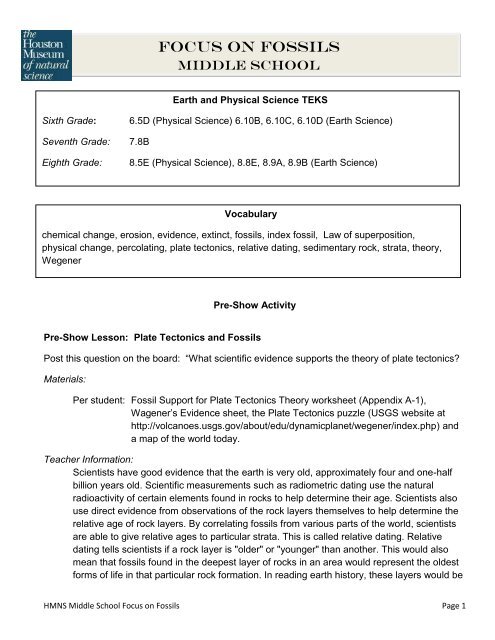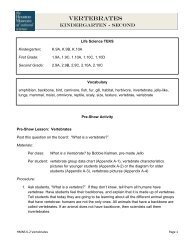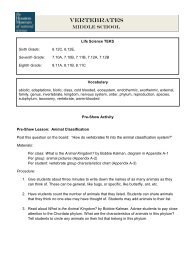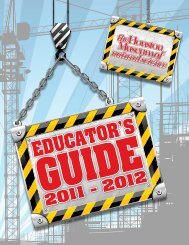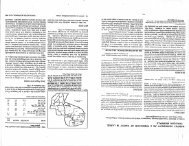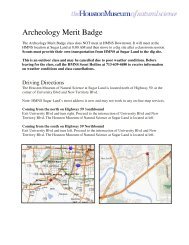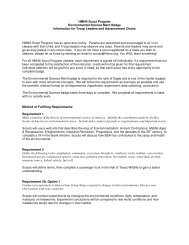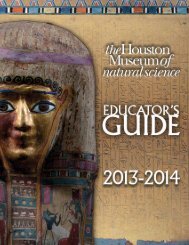Middle School - Houston Museum of Natural Science
Middle School - Houston Museum of Natural Science
Middle School - Houston Museum of Natural Science
You also want an ePaper? Increase the reach of your titles
YUMPU automatically turns print PDFs into web optimized ePapers that Google loves.
Focus on Fossils<br />
<strong>Middle</strong> <strong>School</strong><br />
Earth and Physical <strong>Science</strong> TEKS<br />
Sixth Grade:<br />
6.5D (Physical <strong>Science</strong>) 6.10B, 6.10C, 6.10D (Earth <strong>Science</strong>)<br />
Seventh Grade: 7.8B<br />
Eighth Grade:<br />
8.5E (Physical <strong>Science</strong>), 8.8E, 8.9A, 8.9B (Earth <strong>Science</strong>)<br />
Vocabulary<br />
chemical change, erosion, evidence, extinct, fossils, index fossil, Law <strong>of</strong> superposition,<br />
physical change, percolating, plate tectonics, relative dating, sedimentary rock, strata, theory,<br />
Wegener<br />
Pre-Show Activity<br />
Pre-Show Lesson: Plate Tectonics and Fossils<br />
Post this question on the board: “What scientific evidence supports the theory <strong>of</strong> plate tectonics?<br />
Materials:<br />
Per student: Fossil Support for Plate Tectonics Theory worksheet (Appendix A-1),<br />
Wagener’s Evidence sheet, the Plate Tectonics puzzle (USGS website at<br />
http://volcanoes.usgs.gov/about/edu/dynamicplanet/wegener/index.php) and<br />
a map <strong>of</strong> the world today.<br />
Teacher Information:<br />
Scientists have good evidence that the earth is very old, approximately four and one-half<br />
billion years old. Scientific measurements such as radiometric dating use the natural<br />
radioactivity <strong>of</strong> certain elements found in rocks to help determine their age. Scientists also<br />
use direct evidence from observations <strong>of</strong> the rock layers themselves to help determine the<br />
relative age <strong>of</strong> rock layers. By correlating fossils from various parts <strong>of</strong> the world, scientists<br />
are able to give relative ages to particular strata. This is called relative dating. Relative<br />
dating tells scientists if a rock layer is "older" or "younger" than another. This would also<br />
mean that fossils found in the deepest layer <strong>of</strong> rocks in an area would represent the oldest<br />
forms <strong>of</strong> life in that particular rock formation. In reading earth history, these layers would be<br />
HMNS <strong>Middle</strong> <strong>School</strong> Focus on Fossils Page 1
Procedure:<br />
"read" from bottom to top or oldest to most recent. If certain fossils are typically found only<br />
in a particular rock unit and are found in many places worldwide, they may be useful as<br />
index or guide fossils in determining the age <strong>of</strong> undated strata. By using this information<br />
from rock formations in various parts <strong>of</strong> the world and correlating the studies, scientists<br />
have been able to establish the geologic time scale. This relative time scale divides the<br />
vast amount <strong>of</strong> earth history into various sections based on geological events (sea<br />
encroachments, mountain-building, and depositional events), and notable biological events<br />
(appearance <strong>of</strong> organisms, relative abundance, or extinction <strong>of</strong> certain life forms).<br />
Source: http://www.ucmp.berkeley.edu/fosrec/BarBar.html<br />
1. Students will discuss the question on the board in small groups, and then share ideas with<br />
the class.<br />
2. Make a ‘fossil’ range-chart with your students to illustrate how scientists use relative dating.<br />
a. Choose a group <strong>of</strong> people, for example, teachers in your school. You will want about<br />
10 individuals, some <strong>of</strong> whom have been around for a long time and some <strong>of</strong> whom<br />
have only been there for one or two years.<br />
b. Make a bar graph with years on the X-axis and teachers names on the Y-axis.<br />
Shade the years that correspond with each teacher’s tenure at the school. See the<br />
example below.<br />
Name 90 91 92 93 94 95 96 97 98 99 00 01 02 03 04 05 06 07<br />
Mr. A<br />
Mr. B<br />
Ms. C<br />
Ms. D<br />
c. Imagine that the pages for the yearbooks from 1990 to 2007 were destroyed by a<br />
fire. There are some pages with faculty photographs on them that have been saved,<br />
and the librarian is trying to reconstruct what’s left <strong>of</strong> the yearbooks. Have student<br />
discuss the following questions in groups:<br />
If you find a photo that has Mr. A, Mr. B, and Ms. C in it, what year is it from?<br />
How do you know?<br />
This question illustrates the idea <strong>of</strong> overlapping ranges.<br />
HMNS <strong>Middle</strong> <strong>School</strong> Focus on Fossils Page 2
If you find a photo that has Mr. A and Ms. D, what year is it from? How do you<br />
know?<br />
Assuming Ms D has been there for only a year or so, this question<br />
illustrates the idea <strong>of</strong> an index fossil.<br />
If you find a photo that has Mr. A and Mr. B, but not Ms. C in it, what year is it<br />
from? Does the fact that Ms. C is missing mean anything?<br />
No, not all fossils are found in all rocks.<br />
3. Show students the table in Appendix A-1, which shows geological time periods and<br />
cephalopod fossils that have been found in each one. Students will work in groups to<br />
answer the questions on the bottom and back <strong>of</strong> the page.<br />
4. Turn the data table on its side so that Cambrian era is on the bottom and Quaternary is on<br />
top. Relate this to the law <strong>of</strong> superposition. Scientists study and compare exposed rock<br />
layers or strata in various parts <strong>of</strong> the earth. Physical characteristics <strong>of</strong> rocks can be<br />
compared and correlated. Even between continents, fossil evidence can help in correlating<br />
rock layers.<br />
The Law <strong>of</strong> Superposition states that in an undisturbed horizontal sequence <strong>of</strong> rocks,<br />
the oldest rock layers will be on the bottom, with successively younger rocks on top<br />
<strong>of</strong> these. This law helps geologists correlate rock layers around the world. This also<br />
means that fossils found in the lowest levels in a sequence <strong>of</strong> layered rocks<br />
represent the oldest record <strong>of</strong> life there. By matching partial sequences, the truly<br />
oldest layers with fossils can be worked out. You will also want to point out to<br />
students that most fossils are formed in sedimentary rock and that if we don’t find<br />
fossils in the next layer up, then that is evidence <strong>of</strong> when a species became extinct.<br />
5. Discuss with students how the location that these fossils have been found at supports<br />
Wagener’s theory <strong>of</strong> plate tectonics. Show map in Appendix A-2.<br />
6. Students will complete the plate tectonics puzzle using the key to Wagener’s Evidence<br />
sheet, the puzzle, and a map <strong>of</strong> the world today, all provided on the USGS website at<br />
http://volcanoes.usgs.gov/about/edu/dynamicplanet/wegener/index.php.<br />
7. Watch a video on plate tectonics and the fossil record. You can find these on the NASA<br />
website or through TeacherTube.<br />
HMNS <strong>Middle</strong> <strong>School</strong> Focus on Fossils Page 3
Post-Show Enrichment Activities<br />
Activity One: Permineralization Model<br />
Materials: steel wire, copper sulfate, steel wool (don't use the commercial brands <strong>of</strong> steel<br />
wool that are protected from rusting. They will not react).<br />
Procedure:<br />
1. Students will take steel wire and form it into an organism that could be fossilized.<br />
This should be about a two-three inch model <strong>of</strong> that organism.<br />
2. Fill in the body with pieces <strong>of</strong> steel wool.<br />
3. Make a 2% solution <strong>of</strong> copper sulfate.<br />
4. Fill a container with the copper sulfate solution. Immerse the organism half way.<br />
After a few seconds students should notice that the iron in the steel wool is being<br />
replaced by the copper in the solution. It should turn into pink copper wool. The iron<br />
will take the place <strong>of</strong> copper in the solution. This reaction is exothermic and<br />
produces heat.<br />
Activity adapted from Adventures in Paleontology by Thor Hansen and Irwin Slesnick<br />
Explanation:<br />
Most found dinosaur bones are permineralized. Permineralized fossils are created when<br />
spaces in an organism that usually hold liquids or gasses are filled with mineral rich water. This<br />
happens both in an entire organ like a lung and inside individual cells. As mineral rich water<br />
concentrations increase, those minerals precipitate out, filling the voids and surrounding the cell<br />
walls and cell membranes.<br />
Eventually, all carbon-based tissues will rot, completely decomposing. But through a<br />
complicated chemical process called replacement, even things like cell walls and cell membranes<br />
can be preserved by trading their carbon molecules for rock forming minerals. When this happens,<br />
a large amount <strong>of</strong> biological detail is preserved, especially when the replacing minerals differ from<br />
minerals that caused the permineralization. For example, when silica-rich water is the<br />
permineralizing agent and iron pyrite replaces the tissues, paleontologists can see internal cellular<br />
structure. They can even distinguish between different cell organelles! This is only possible when<br />
the fluid space within individual cells is also permineralized. This high quality form <strong>of</strong><br />
permineralization is called petrifaction and commonly occurs in petrified wood. So to be petrified,<br />
objects end up containing none <strong>of</strong> their original chemistry.<br />
Information Source: National Parks Service<br />
HMNS <strong>Middle</strong> <strong>School</strong> Focus on Fossils Page 4
Activity Two: Chemical or Physical Change<br />
Materials: fossilization cards (Appendix A-3 through A-5)<br />
Procedure:<br />
1. Make copies <strong>of</strong> the seven fossilization cards in Appendix A-3 through A-5, one set<br />
for each partner.<br />
2. Students will create a T-chart in their science notebook. The first column is titled<br />
“Chemical or Physical Change”. The second column is titled “Explanation”. They<br />
should have 7 rows in their T chart; one row for each fossil example (see Appendix<br />
A-6 for an example).<br />
3. Students will identify each card as a chemical or physical change and explain in their<br />
T-chart. They should be prepared to share their results with the class.<br />
Physical changes may involve changes in size and shape or changes <strong>of</strong> state but with<br />
no loss <strong>of</strong> identity. No new substances are formed during physical changes. Physical<br />
changes are brought about by cutting a substance into small pieces or by heating or<br />
cooling to change its physical state. Melting, dissolving and vaporization are examples<br />
<strong>of</strong> physical change.<br />
Chemical changes change the identity <strong>of</strong> a substance. The original substance is lost<br />
and entirely different substances are formed. Chemical changes occur when a<br />
substance decomposes into simpler substances or when two chemicals combine to<br />
form an entirely new substance.<br />
Activity Three: Fossils in Texas<br />
Materials: article<br />
Procedure:<br />
1. Ask students how scientists find fossils if they were buried millions <strong>of</strong> years ago.<br />
Discuss their ideas.<br />
2. Students will make a three column chart in their science notebook. In the first<br />
column they will record everything they know about fossils.<br />
3. Students will read the article in Appendix A-7 and fill in the second column with<br />
everything they learned.<br />
4. In the last column they will write questions or comments that they have that relate to<br />
the text.<br />
HMNS <strong>Middle</strong> <strong>School</strong> Focus on Fossils Page 5
What I know about TX<br />
Fossils<br />
What I learned from the<br />
article<br />
Questions/Comments<br />
Teacher Information:<br />
When scientists go out prospecting for fossils, erosion is their best friend. Most <strong>of</strong> the “life”<br />
<strong>of</strong> a fossil is spent deep underground, encased in rock, and it is only after erosion slowly<br />
breaks apart the rock matrix covering it that a fossil can be discovered. You can find more<br />
information and pictures <strong>of</strong> the gorge on their website.<br />
HMNS <strong>Middle</strong> <strong>School</strong> Focus on Fossils Page 6
Cambrian<br />
Ordovician<br />
Silurian<br />
Devonian<br />
Mississipian<br />
Pennsylvanian<br />
Permian<br />
Triassic<br />
Jurassic<br />
Cretaceous<br />
Tertiary<br />
Quaternary<br />
Appendix:<br />
A-1<br />
Name ________________________________________<br />
Date ________________________<br />
Fossil Support for Plate Tectonics Theory<br />
Cephalopod<br />
Goniatites<br />
Ceratites<br />
Ammonites<br />
Nautiloids<br />
Orthocones<br />
Belemnites<br />
Teuthids (squids)<br />
Octopods (octopus)<br />
Data Analysis<br />
1. If you have a rock that has a Ceratite in it what time period(s) is it from? How do you know?<br />
2. If you have a rock that has a Goniatite and a Nautiloid what time period(s) is it from? How do<br />
you know?<br />
3. If you have a rock that has an Ammonite and an Orthocone in it, what time period(s) is it from?<br />
How do you know?<br />
4. If you find a rock that has an Orthocone what time period(s) is it from? How do you know?<br />
5. Which fossils might you expect to find in a rock <strong>of</strong> Jurassic age?<br />
HMNS <strong>Middle</strong> <strong>School</strong> Focus on Fossils Page 7
6. If you find a sedimentary rock that has no Cephalopods in it, can you tell what time period it is<br />
from (using the information available in this lab only)? Why or why not?<br />
7. Which fossil(s) make the best index fossils?<br />
8. Cephalopods are organisms that lived in the open ocean. During the Cretaceous, a lack <strong>of</strong><br />
oxygen in ocean basins meant that large deposits <strong>of</strong> organic material built up. This material came<br />
primarily from microorganisms in the ocean water. This material was later buried and eventually<br />
became oil. Geologists from oil companies frequently use range charts to help them date rocks so<br />
that they might find more oil. Imagine that you are an oil geologist. What types <strong>of</strong> cephalopods<br />
most likely became oil?<br />
HMNS <strong>Middle</strong> <strong>School</strong> Focus on Fossils Page 8
Answers to Data Analysis Questions:<br />
1. Triassic<br />
2. Mississippian or Pennsylvanian<br />
3. Triassic<br />
4. Ordovician to Triassic<br />
5. Ammonites, Nautiloids, Belemnites, Teuthids, Octopods<br />
6. It is impossible to tell because the absence <strong>of</strong> ammonites might only mean that no ammonite<br />
happened to be preserved in that particular piece <strong>of</strong> rock or it might mean that the rock came from<br />
a time period when no cephalopods existed.<br />
7. Ceratites<br />
8. Ammonites, nautiloids, belemnites, teuthids, octopods<br />
HMNS <strong>Middle</strong> <strong>School</strong> Focus on Fossils Page 9
A-2<br />
Graphic Source: USGA<br />
HMNS <strong>Middle</strong> <strong>School</strong> Focus on Fossils Page 10
A-3<br />
1. Permineralization (Petrification): Mineral matter from percolating ground<br />
water is added to pores and cavities in bones, shell, teeth, etc. In this type<br />
<strong>of</strong> preservation the original material is still present with new mineral matter<br />
added to the void spaces. Many dinosaur bones are preserved by this<br />
method. Not all <strong>of</strong> the original material is replaced.<br />
2. Replacement: Original hard parts (bone, in the case <strong>of</strong> dinosaurs) are<br />
replaced with new mineral matter <strong>of</strong> a different composition than the<br />
original mineral matter (<strong>of</strong>ten at a molecular level, so the microstructure <strong>of</strong><br />
the original mineral matter is preserved). Silica (as microcrystalline quartz,<br />
SiO 2 ), iron oxide (hematite, Fe 2 O 3 ), and calcium carbonate (calcite, CaCO 3 )<br />
are common replacement minerals (they are also common permineralizing<br />
agents). Replacement is similar to permineralization, except that in<br />
replacement all <strong>of</strong> the original material is replaced.<br />
3. Recrystallization: In recrystallization, the original mineral present simply<br />
recrystallizes. The original crystals grow larger and fill most <strong>of</strong> the void<br />
space. This form <strong>of</strong> preservation usually destroys or partially obscures the<br />
original microstructure <strong>of</strong> the skeletal material. An example would be the<br />
recrystallization <strong>of</strong> a clam shell originally composed <strong>of</strong> the mineral<br />
aragonite to calcite. This is more common in invertebrate fossils<br />
(brachiopods, gastropods, etc.) than in vertebrate fossils.<br />
HMNS <strong>Middle</strong> <strong>School</strong> Focus on Fossils Page 11
A-4<br />
4. Carbonization: Sometimes s<strong>of</strong>t parts and/or hard parts <strong>of</strong> the body <strong>of</strong> an<br />
organism are compressed by burial before decomposition is complete. As a<br />
result, the volatile substances (such as oxygen, nitrogen, carbon dioxide,<br />
water, etc.) are squeezed out, leaving behind a film <strong>of</strong> fairly pure carbon.<br />
This is particularly common in the preservation plant fossils (such as ferns<br />
and leaves, and some invertebrates, but also occurs sometimes for<br />
vertebrates.<br />
5. Molds and Casts: Sometimes the hard parts (bone or other material), and<br />
sometimes even s<strong>of</strong>t tissue), <strong>of</strong> organisms are buried by sediment and<br />
remains until the sediment is hardened by compaction and cementation.<br />
Later, it is dissolved by acidic ground waters percolating through the pores<br />
<strong>of</strong> the rock or decomposed by other processes. This will leave an<br />
impression <strong>of</strong> the external body <strong>of</strong> the organism. This is called an external<br />
mold. If later the mold is filled in with mineral matter or sediment, a cast is<br />
formed which mimics the external body <strong>of</strong> the original material. Sometimes<br />
internal cavities <strong>of</strong> skeletons may be filled with sediment or mineral matter<br />
resulting in a mold <strong>of</strong> the internal body parts that were filled. This is called<br />
an internal mold.<br />
6. Organic Traps: Insects, spiders, and even small lizard have been found,<br />
nearly perfectly preserved in amber. Picture this scenario: A fly lands on a<br />
tree branch and is looking for food. It steps in sticky sap that the tree has<br />
made and is covered in the sap. The sap then hardens over time,<br />
becoming amber, and trapping the fly inside, preserving it.<br />
HMNS <strong>Middle</strong> <strong>School</strong> Focus on Fossils Page 12
A-5<br />
7. Freezing This is the best means <strong>of</strong> preservation <strong>of</strong> ancient materials, but it<br />
happens rarely. The animal must be continually frozen from the time <strong>of</strong><br />
death until discovery. That limits the possibilities to cold, hardy animals<br />
from the last ice age. There have been remarkable discoveries <strong>of</strong><br />
mammoth and wooly rhinoceros found in ice from Alaska and Siberia.<br />
Specimens with flesh, skin, and hair intact have been found. Some <strong>of</strong> these<br />
finds suggest that they were frozen with food still in the mouth and<br />
stomach.<br />
HMNS <strong>Middle</strong> <strong>School</strong> Focus on Fossils Page 13
A-6<br />
Examples <strong>of</strong> Possible Answers:<br />
Type <strong>of</strong> Fossil<br />
Chemical or Physical Change to Organism<br />
1. permineralization Physical change because the original material<br />
is still there. Minerals from the ground water<br />
have just been added which changed it<br />
physically. This could also be a chemical<br />
change if some <strong>of</strong> the organism was<br />
decomposed.<br />
2. replacement Physical change minerals from the ground<br />
water have been added which changed it<br />
physically. This is also a chemical change<br />
because the organism was decomposed.<br />
3. recrystalization Chemical change because the original crystals<br />
are changing from one type <strong>of</strong> matter into<br />
another. This may also be a physical change if<br />
the shape has changed at all, which more than<br />
likely it has.<br />
4. carbonization This is both a chemical and physical change. It<br />
changes shape when it is compressed and<br />
there is also decomposition so there is a<br />
chemical change.<br />
5. molds and casts A chemical change is happening because <strong>of</strong><br />
decomposition. A physical change is<br />
happening because the organism is changing in<br />
size and in the case <strong>of</strong> a cast, the organic<br />
matter is being replaced with mineral matter.<br />
6. organic traps The organism is preserved so it is possible that<br />
no physical or chemical change has occurred.<br />
7. freezing The organism is preserved so it is possible that<br />
no physical or chemical change has occurred.<br />
HMNS <strong>Middle</strong> <strong>School</strong> Focus on Fossils Page 14
A-7<br />
Canyon Lake Gorge <strong>of</strong>fers summer learning<br />
ZEKE MacCORMACK, San Antonio Express-News<br />
Tuesday, June 19, 2012<br />
CANYON LAKE, Texas (AP) — Textbooks couldn't compare to the experience <strong>of</strong> essentially<br />
walking back in time over fossils and dinosaur tracks left 110 million years ago.<br />
"This is way cool. I love this," <strong>Houston</strong>-area teacher Tammy Koonce said while navigating the<br />
Canyon Lake Gorge with other members <strong>of</strong> the Texas Alliance for Geographic Education.<br />
The group followed in the footsteps <strong>of</strong> scientists, eco-tourists and other educators who have<br />
explored the landmark, which was created a decade ago by record flooding on the Guadalupe<br />
River.<br />
Beyond honing lesson plans on the outing last week, the geography teachers marveled at the<br />
idyllic setting.<br />
"It's probably one <strong>of</strong> the best-kept secrets in all <strong>of</strong> Texas, in terms <strong>of</strong> natural beauty," said Greg<br />
Hill, a teacher in Mesquite. "Usually when I teach physical geography, we have to talk about<br />
somewhere far away."<br />
Long after the replacement <strong>of</strong> homes, cars and other belongings lost to the devastating flood, "the<br />
gorge" will stand as testimony to the power that nature unleashed in the summer <strong>of</strong> 2002.<br />
The historic rush <strong>of</strong> water through the spillway at Canyon Lake dam — estimated at one-third the<br />
flow <strong>of</strong> Niagara Falls — carved a ravine more than a mile long, and deeper than 50 feet in spots,<br />
in the limestone hillside beside the dam.<br />
By the time the flows subsided six weeks later, an estimated 600,000 cubic yards <strong>of</strong> rock and dirt<br />
had eroded, or enough to cover a football field 30 feet deep.<br />
"One hundred million years ago, this was actually the shoreline <strong>of</strong> Texas," tour guide Cinde<br />
Thomas-Jimenez told the educators, pointing out rippled rocks that signify a prehistoric beach.<br />
Boulders washed out <strong>of</strong> the gorge in 2002 created a blockage below the dam, she said, causing<br />
the water coming out <strong>of</strong> the dam's release valve to back up into nearby neighborhoods.<br />
"It was really, really devastating for the people who lived here."<br />
The flood's scouring also revealed a large seismic fault, two sets <strong>of</strong> dinosaur footprints and<br />
countless fossils, as well as springs and seeps.<br />
HMNS <strong>Middle</strong> <strong>School</strong> Focus on Fossils Page 15
The newly formed natural wonder immediately attracted geologists, as well as curious laymen,<br />
prompting the Guadalupe-Blanco River Authority to establish a touring initiative in conjunction with<br />
the Army Corps <strong>of</strong> Engineers, which owns the gorge property and manages the reservoir.<br />
"It's a fantastic outdoor classroom," said GBRA staffer Jaynellen Ladd, who estimated 10,000<br />
people have taken the $10-per-person, three-hour tours since they began in 2007.<br />
"Once people go in, a lot <strong>of</strong> them say, 'I didn't realize it was so huge,'" Ladd said.<br />
The outings are staffed by GBRA employees and volunteers with the Gorge Preservation Society,<br />
a support group <strong>of</strong> about 75.<br />
The faults, fractures and rock deformations are <strong>of</strong> great interest to oil companies, which frequently<br />
send workers on the tour, said Ronald McGinnis, a senior research scientist at Southwest<br />
Research Institute.<br />
"It's an amazing training laboratory for all scales <strong>of</strong> geosciences," he said, "We can study how<br />
these fractures and faults control fluid movements. It's basically the inner workings <strong>of</strong> an aquifer,<br />
exposed."<br />
HMNS <strong>Middle</strong> <strong>School</strong> Focus on Fossils Page 16


